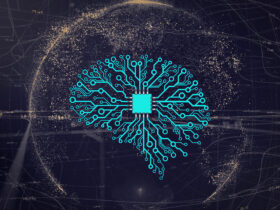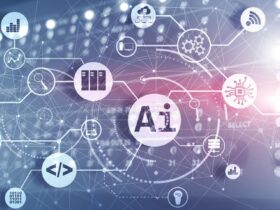There has been a boom in edge computing in many industries seeking to leverage artificial intelligence for their business.
Smart infrastructure can improve operational efficiency, safety, and financial results.
When developing and deploying AI applications, enterprises combine edge computing and cloud computing.
So you’re also thinking about deploying AI at the edge too?
Then here is your answer.
Many organizations are considering deploying learning-based systems at the edges, but there are a few key factors to consider.
Keep reading to know more.
What Is Edge AI?
Edge artificial intelligence is an AI workflow that uses centralized data centers (the cloud) and non-cloud devices close to people and objects (the edge).
Most AI applications are developed and run on the cloud, which people have started calling cloud AI.
Additionally, it differs from older AI approaches in which AI algorithms are developed on desktop computers and then deployed on desktops or special hardware for specific jobs, such as scanning check numbers.
An edge device is often described as a physical object, for example, a network gateway, a smart router, or an intelligent 5G cell tower.
As a result, edge AI cannot get considered for devices that include autonomous vehicles, robots, and cell phones.
A great way to understand the importance of edge ai is that it makes cloud innovations available globally.
In recent years, a few edge innovation types have improved the efficiency, performance, security, management, and operation of computers, smartphones, vehicles, appliances, and other devices that use cloud best practices.
Edge AI focuses on extending machine learning, AI, and data science outside the cloud using the best practices, architectures, and processes available.
How Does Edge AI Work?
To emulate human skills, machines must be able to replicate human intelligence. For example, they can see, detect objects, drive cars, understand speech, speak, and walk similarly to humans.
Artificial Intelligence uses a structure known as a deep neural network to replicate human cognition.
To train these DNNs, they get fed a dataset containing specific questions and their correct answers. This training process is called “deep learning.” Generally, this process runs on cloud servers or data centers as the training data is of a vast amount in size. For training an accurate model, it needed to collaborate with data scientists when configuring the model.
The trained model can answer real-life questions as an “inference engine.”
Generally, edge AI gets deployed in various locations, including factories, hospitals, cars, satellites, and homes. Inference engines run on computers or devices in these remote locations.
Whenever the AI encounters a problem, this troublesome data gets uploaded to the cloud and trained further, after which the cloud-based system eventually replaces the edge inference engine.
Model performance gets significantly boosted by this feedback loop; edge AI models become more sophisticated with time.
What Is Edge Computing?
Edge computing is an architecture based on distributed information Technology. In this system, the client data gets processed near the originating data source. Most businesses depend on data to provide valuable business insights and decision-making support in real-time.
In the digital era, businesses make a massive amount of data from sensors and IoT devices that function remotely globally.
Business models are also changing because of this vast amount of data. An infrastructure built on centralized data centers and the internet is improper for storing and working on increasing amounts of real-world data.
The bandwidth limitations, latency issues, and unpredictable network disruptions can get obstacles to these efforts. But edge computing architecture helped businesses to overcome these data challenges.
Edge computing refers to moving data storage and computing resources closer to the data’s point of origin.
Raw data is processed and analyzed at the data generation point rather than being transmitted to a central data center; it can be in retail stores, factories, utilities, or smart cities.
The results of that computing work get forwarded to the central data center for review and human interaction, including real-time business insights and maintenance predictions.
Benefits Of Edge AI
The following are some of the benefits of edge AI over cloud AI:
Reduced latency/higher speeds.
The interfacing gets done on the local system. Thus, the communication time with the cloud waiting for response time gets reduced. It also increases the performance speed.
It reduced bandwidth requirements and cost.
With Edge AI, voice, video, and high-fidelity sensor data can get transmitted over cell networks with reduced bandwidth and associated costs.
It increased data security.
The data processing gets performed on the local system, which reduces the risk of sensitive data stored on the cloud system.
They have improved reliability/autonomous technology.
The AI program can function well even in a network-down situation. This functionality is essential in many sectors, including autonomous vehicles and industrial robots.
Reduced power.
As most AI tasks get performed on the local system, this drops the energy required to send data to the cloud and wait for a response. Additionally, this also increases the battery life of the device.
Challenges With The Edge AI And How To Solve Them
Although AI at the edge has many benefits, it also poses some unique challenges. The following tips can help you address those challenges.
Training model outcomes: good and bad
In most AI techniques, a model gets trained using a large amount of data. The industrial use cases at the edge can get more challenging because most manufactured products are not defective, so they must get annotated or tagged as good.
Because of this, models cannot recognize problems due to the imbalance between “good outcomes” and “bad outcomes.”
AI or magic can’t solve all problems.
Output is often the result of many steps. On factory floors, for instance, there can be many interdependent stations. During one process in the factory, the humidity in one area can affect the results in another process later in the line.
People tend to think that AI can magically unravel all these relationships. Although it may be possible in most cases, it can also take a lot of data and a long time to collect, making it difficult to explain and update.
Scaling AI gets limited by stakeholder acceptance.
AI cannot effectively get scaled across an organization if its benefits get questioned by many people. Starting with a high-value, complex problem and solving it with AI is the best (and perhaps only) way to get broad buy-in.
Top Considerations For Deploying The Edge AI
Scalability:
Edge computing is an ideal way to scale infrastructure besides delivering high computing with low latency. When using a centralized cloud solution, data movement and processing get limited.
Often, bandwidth caps increase costs and lead to a smaller infrastructure. As edge computing solutions are based on the local area network (LAN), data collection, processing, security, and remote management occurs in that network. This allows for higher bandwidth and greater scalability.
Since data gets processed on the LAN, there can be significant cost savings by eliminating the need to move data between the cloud and the LAN.
Remote Management:
One major challenge of adopting edge computing is requiring skilled data center technicians to set up and maintain systems at remote locations. Installing and managing edge computing solutions should be easy to avoid this time-consuming and costly process.
Besides, you must install the latest updated software on edge systems. A simple solution to this problem is to adopt a management platform that simplifies the deployment, management, and edge-based application scalability.
Remote management platforms are essential if you’re planning a large edge deployment.
Security:
Data privacy and security are immediately associated with distributed edge computing. Data privacy and the protection of AI models trained to deliver accurate insights became crucial.
In many edge computing solutions, however, users are responsible for security. You may find it hard to create a security model from scratch unless you have security experts on staff.
This is why you should choose a platform that offers full-stack security features. Take data encryption into consideration when evaluating computing platforms. Encrypting both improves your data security posture and helps protect your data.
If you’re considering management platforms and compute infrastructure together, ensure that your application is secure before deploying it.
Few advanced platforms provide features such as malware and vulnerability scanning and signed containers. If your company has a security team dedicated to developing custom solutions, you can choose a platform with few or no security features.
Resilience:
Due to the distributed nature of edge computing, edge solutions can experience software or system failures. Essentially, that would mean sending a skilled IT professional to the location and rebooting or updating the system, a process that can be time-consuming and expensive.
Thus, edge systems should get managed remotely with a resilient platform.
In simple terms, resilient software can resolve issues without human interaction. The flexibility of resiliency can allow for self-healing applications and the migration of workloads to a different system. They ensure that applications will always work and insights will never get lost.
How To Deploy The Edge AI
Mobile devices and IoT hardware have limited computing power, memory, and storage.
Due to these limitations, direct deployment of deep learning models is a little challenging, especially if they are large and need extensive computations.
Optimizing techniques like compilation and quantization are critical to the deployment process to the edge.
The deep learning model optimization and their readiness to get deployed at the edge is only the beginning. The inference pipeline in production must also get assessed and improved.
The inference process behaves and acts differently in the production environment compared to the research phase, where there is no pipeline (only forward-pass).
Everything from hardware to operating systems to applications to users gets involved.
For optimal production performance, five components should be considered.
Inference server.
The inference server executes your model algorithm, which returns your inference result. Pipelines depend on this part, so it must live up to expectations. When selecting an inference server, ensure that it is flexible, dynamic, and easy to deploy.
Client and server communication.
An application with client and server components divides the responsibilities between the providers of resources (servers) and the service requesters (clients). Clients and servers must share and transfer data to speed up communication.
Batch size.
The batch size refers to how many training examples get used in one forward/backward pass. Boosting inference performance in production can be achieved by optimizing it. To choose the right batch size, consider model memory consumption, model replication, and model task.
Code optimization.
Changing code is one of the fastest things you can do. Using asynchronous code can help you achieve this since it performs many requests simultaneously, so you can use a future object when needed.
Serialization.
Data or object instances get serialized to create a format for storing, transporting, and reassembling state information. Due to its data manipulation and CPU blockade, the process affects latency. Different methods can get employed to reduce the memory footprint.
Conclusion
In the field of artificial intelligence, edge computing, or AI at the edge, is a significant development.
The main idea of this approach is to ensure that the AI algorithms get computed near the data site rather than sending it back to the cloud for processing.
As a result, AI systems’ training time gets reduced, and their accuracy gets increased. By leveraging the cloud’s power and local processing, Edge Computing aims to maximize efficiency.
This way, latency gets minimized, bandwidth constraints are optimized, and costs are reduced.












